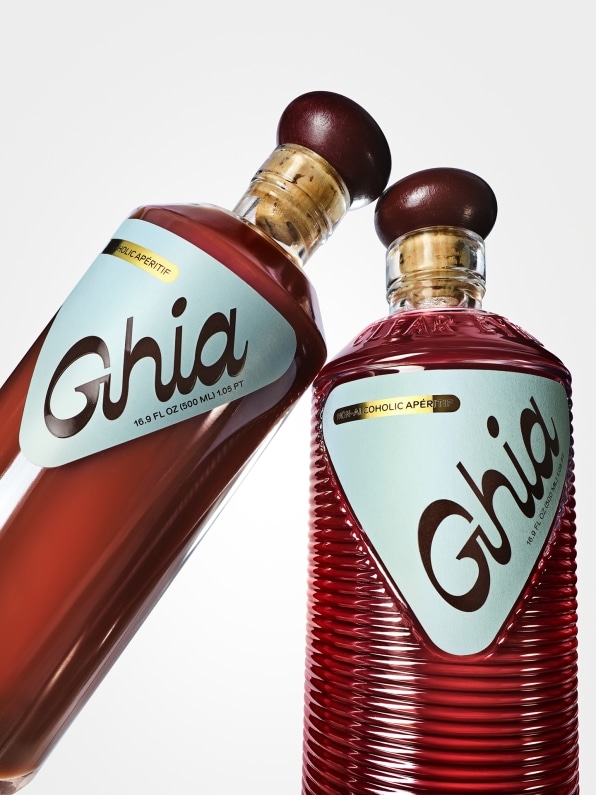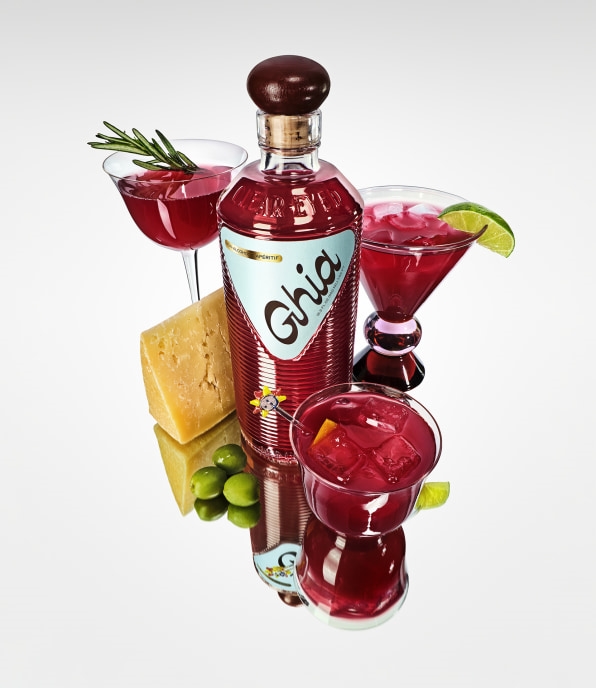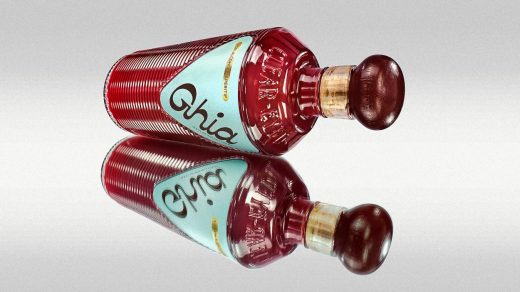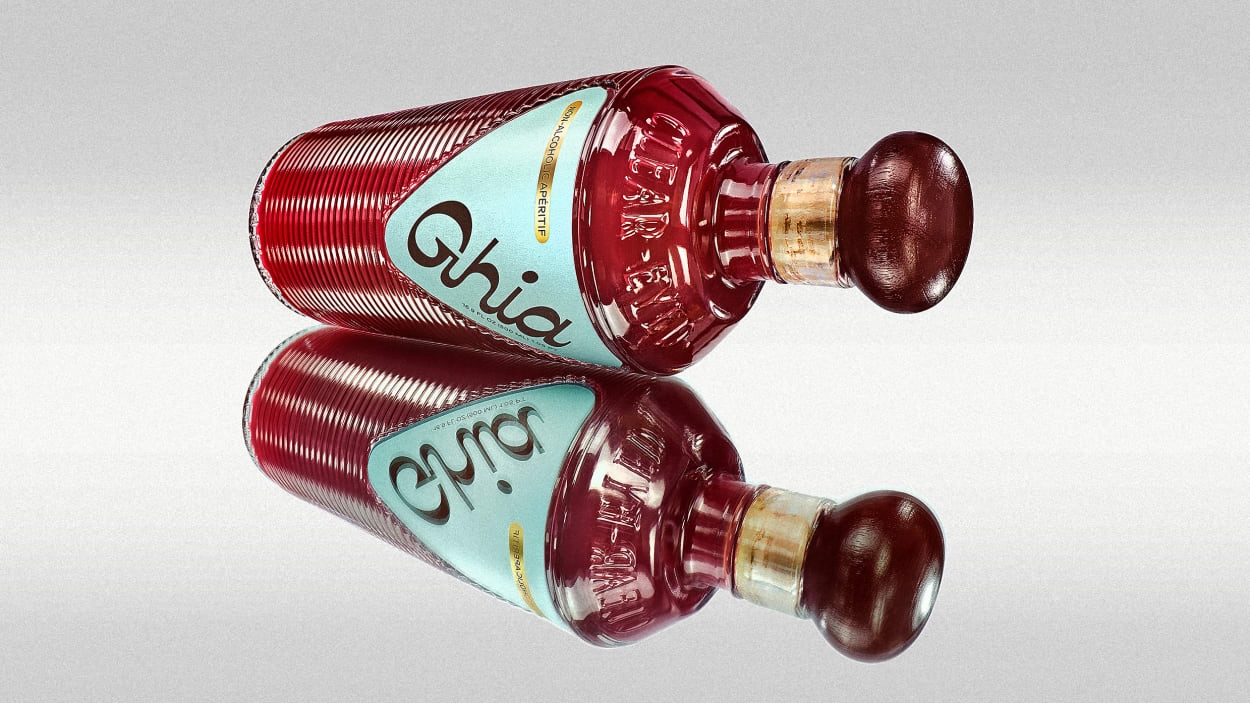Ghia, the nonalcoholic aperitif, has a redesigned bottle that’s ribbed for your pleasure
If Domino magazine’s viral feature on nonalcoholic beverage company Ghia’s headquarters—a bright and airy Tudor home in the Hollywood Hills of Los Angeles, complete with bedrooms and a backyard—revealed one thing, it’s that the brand cares about chic. The founder, Dig Inn and Glossier alum Melanie Masarin, goes out of her way to mention the ’90s Mercedes she drives to work. The company’s office features a coveted 1972 Étienne Fermigier sofa. The snack of choice? West-bourne’s $13 bags of Togarashi Crunch. (Though maybe not on the Fermigier.) To keep the office uncluttered, the company has a clean-desk policy. Why let efficient get in the way of beautiful?
On April 12, Ghia debuts the redesign of its Instagram-friendly bottle as well as a reformulation of its spirits-free aperitif.
In keeping with its try-hard-chill office vibes, it is beautiful . . . and a lot of work has gone into it. The company has taken a Glossier-like approach to product development, using customer feedback to adjust its signature product. “We’ve learned so much over the past three years about how our customers like to drink it, how and when they use it, what they think when they see it,” Masarin says. “We’re taking into account their feedback to deliver a better experience.”

That starts with the bottle. “We always wanted to make a custom bottle, but it’s much more expensive unless you do it at scale,” Masarin says. “Our first run, when we used stock bottles, was 1,200 units. Now we placed an order for 80,000.”
That original receptacle was an 18-ounce cylindrical number, elevated by a knobby cork and the brand’s distinctive—and influential—script, which has been called both nostalgic and modern and evocative of old French poster typography. The design and appearance of the bottle has long been an important selling point for Ghia, which launched as a direct-to-consumer brand in June 2020—at the height of the pandemic—when shoppers had to purchase the product based solely on its aesthetics and not on taste.

The redesign—executed by Willo Perron and Brian Roettinger, who designed Rihanna’s Super Bowl halftime show—adds ribbed lines and an embossed “Clear Eyed & High Minded” tagline. It’s intended to be reused as a keepsake. Masarin adds that she hopes the bottle will enhance the drinking and serving experience. “We were thinking about the five senses,” she says. “Now you can smell it, taste it, see the bottle, and touch the ribbed glass, which is unique to us.”
As for what’s inside the bottle, Masarin had always been inspired by Mediterranean aperitivo culture, and this reformulation is arguably more bold than the bottle. Ghia 2.0 omits fig, which often left a sediment at the bottom of the bottle as unsightly as a smattering of papers on a Ghia desk. The new aperitif features a mix of date, rhubarb, and plum. That means that the concentrate’s signature cloudy red color is set to look a little more clear.
It’s also designed to save consumers money: The new Ghia is 46% more concentrated than the original, so a ribbed bottle will contain 17 servings rather than the previous 10—for the same $38 price. “I think the biggest upset with [our product] is that it is very expensive,” Masarin admits. “This entire [nonalcoholic] category in general is meant to create more inclusivity.”
The category is certainly generating sales—and minting a number of successful entrepreneurs, as traditional beverage giants see nonalcoholic spirits as a growth segment. Diageo acquired a majority stake in nonalcoholic spirit company Seedlip in 2019, and holds a minority stake in Ritual Zero Proof. In November, Keurig Dr Pepper invested $50 million in nonalcoholic craft beer maker Athletic Brewing Co.
Would Masarin, who tells me that Ghia has grown 77% over the past year, ever consider being acquired by a bigger brand? “We are and will continue to be incredibly intentional with our investment partners,” she says, adding, “We are open to exploring conversations with bigger partners so we can continue taking back the word drinking from alcohol.”
On its own, Ghia has expanded its offerings to include spritzes, a hazelnut spread, glassware, and even a tabletop puzzle. Although the company’s brand extensions can be found in bodegas and supermarkets, the bottled drink, perhaps in part due to its visual appeal (which translates well on social media), still accounts for 50% of Ghia’s sales.
When Masarin introduced Ghia, she marketed it as having the taste of summer on the rocks. At the time, the drink—combined with its Instagram account, replete with images of the Mediterranean—transported drinkers to a better place than the COVID-infused moment in which it arrived. So three years later, with society very much over the pandemic, does the reformulated Ghia still taste like summer on the rocks? No idea, but the slightly bitter, citrusy taste is pretty good.
(16)



